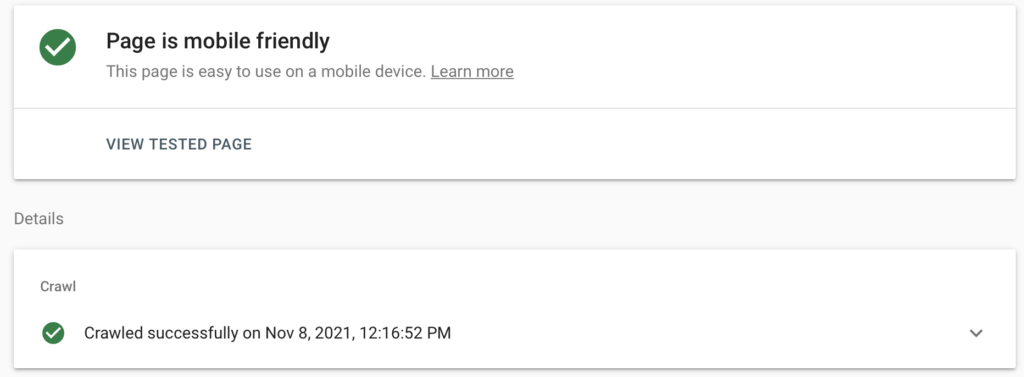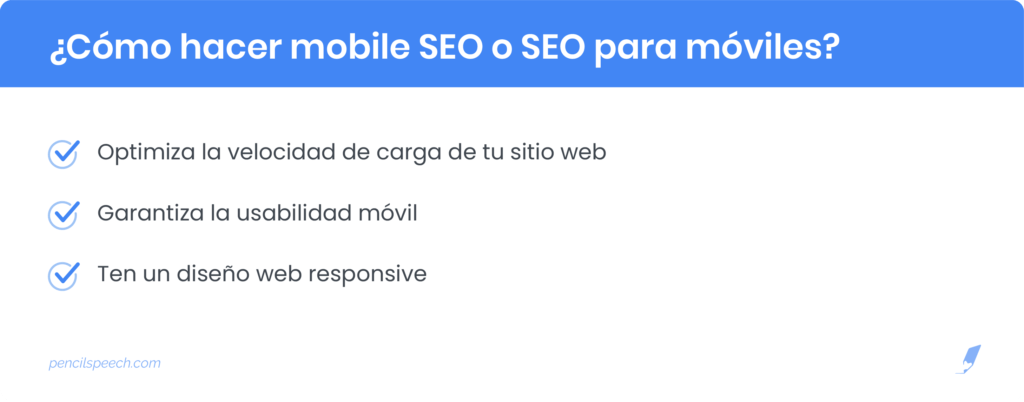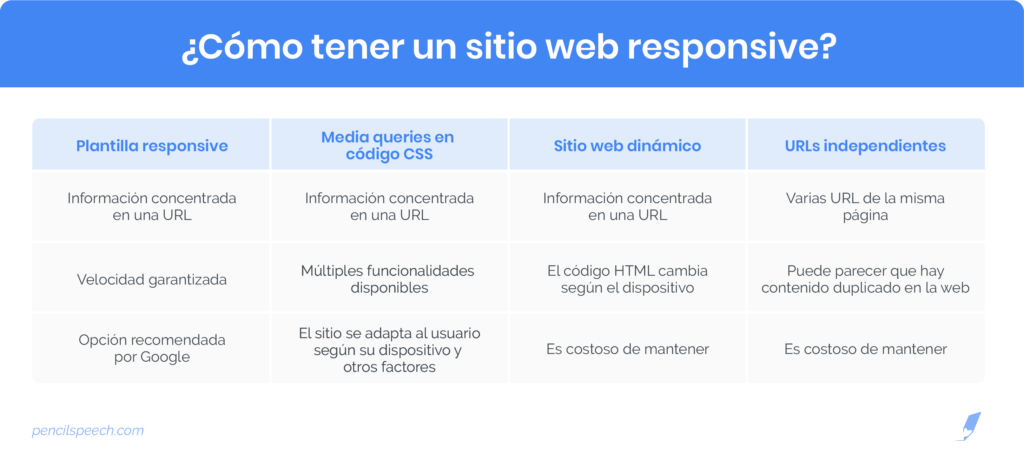How to do mobile SEO or mobile SEO?
- Optimize the loading speed of your website: reduce the weight of the images, clean the code of your site, uninstall plugins that you do not use and contract a quality hosting.
- Ensure mobile usability: browse your site from smartphones and tablets to check that everything looks and works properly.
- Have a responsive web design: for this you can use a responsive template, use media queries in the CSS code, build a dynamic site or have independent URLs.
According to the Google Search Center , 94% of the American population searches for information through their phones.
And that’s just in the United States.
Hence, companies must include the best mobile SEO or mobile SEO practices in their web strategy.
The better the stay of people on your website, you will have more engagement, more visits and, therefore, more sales.
What is mobile SEO?
Mobile SEO or SEO for mobile is the set of measures and strategies for a website to be compatible with mobile devices, such as smartphones or tablets.
What is mobile friendly?
Mobile friendly is the description given to a website when it is easy and “friendly” to navigate through mobile devices.
In other words, a mobile friendly site is what you want to achieve when implementing user experience and SEO recommendations for mobiles.
What is Mobile First Index?
Mobile First Index is a Google policy that prioritizes among its results those websites that have a mobile version.
How to check if your website is compatible with Mobile First Index?
Enter your domain URL into Google’s mobile-friendly test and instantly check whether your website is mobile-optimized or not.

Is AMP setup still required?
No. Pages with Accelerated Mobile Pages (AMP) used to get preferential treatment because they created a lightweight, fast-loading version of the content on a page.
However, from June 2021 Google announced that it would no longer take this into account as a ranking factor.
How to improve your mobile SEO?
Although the recommendations can be many, we have grouped them into 3 big steps:

Read on to learn about each of them:
Optimize your loading speed
According to a study conducted by Google, more than 54% of people abandon a page if it takes more than 3 seconds to load.
Less than 3 seconds: that is your window to load the content on your website.
How to improve this factor?
1. Know how fast your site currently loads
For this you can use the following tools:
- Test My Site : Designed by Google, it offers recommendations to improve the performance of your domain on mobile devices.
- PageSpeed Insights – Also created by Google, it allows you to measure the loading performance of individual pages, both on mobile and desktop.
2. Compress the weight of images
Unoptimized images in heavy formats will unnecessarily burden the speed of your website.
The recommended formats are:
- JPEG2000.
- JPEGXR.
- WebP.
These formats are compatible with modern browsers and allow resources to load faster.
3. Get rid of unnecessary animations and visual effects
Just like unoptimized images, animations, gifs, and effects will slow your website down.
As much as possible, choose a simple aesthetic, with few animations and props.
4. Remove plugins you don’t use
If your website has the possibility of installing plugins, it is possible that on more than one occasion you have abused this functionality.
It is important to periodically review which plugins are still necessary for the website to function and eliminate all those that are not.
Even if they are not activated, if they are installed on your website, they will most likely add to its total weight and, therefore, to its loading time.
5. Reduce the code of the pages
With the help of a programmer or developer, remove unnecessary spaces, lines and characters from the source code of your website.
This will help you reduce the size of the site file, i.e. minimize the javascript.
6. Set priority content in the HTML code
In the HTML code of each page, indicate which content and resources are a priority so that the browser retrieves them from the server and loads them first.
This will mean that, for example, on a page where the most important thing is the text, that will be the first thing visible to the user.
They will then upload the images, visual styles, and any other details that are not as important as the written information.
7. Check the specifications of your hosting
Hosting or hosting service is the plot of land on the Internet where you have built your website.
Depending on the provider and the plan you have chosen, your site will load your users more or less quickly.
Ensure mobile usability
Users who browse a website from their mobile phones behave differently than those who do it from their computers.
For the optimal experience for people on any device, you should check how each page of your site looks on different types of mobile devices:
Types of mobile devices and their measurements
Google recognizes 4 models of mobile devices:
- Smartphones – Their screen sizes are typically 480px. It refers to modern mobiles that handle operating systems such as Android, iPhone and Windows Phone. The browsers used by phones are similar to those used by computers, therefore, they are compatible with HTML5.
- Tablets : their standard size is 768px . Google considers tablets to be in a class of their own. In other words, because tablets have much larger dimensions, they do not use a mobile browser; on the contrary, users expect to see the website as if they were on their computers.
- Media Phones – While media phones have a number of features (solar battery charging, high-quality sensors) they often don’t support HTML5, so they’re not optimal for visiting websites.
- Basic Phones – Phones in this class cannot render any kind of HTML features.
Now, there are several ways to ensure mobile usability:
How to have a responsive website?
There are four main ways to have a responsive website:

Use a responsive template
These days, most websites are built with tools like WordPress or Wix.
One of the advantages of these platforms is that they facilitate the mobile usability of the sites with the offer of responsive templates.
These templates automatically from each page and module have an optimized equivalent for different screen sizes.
By making use of a responsive design, the server sends the same HTML code to all devices, so that the content is then rendered and compatible.
This is the option that Google recommends implementing because:
- There is no need to redirect users to another URL, so the loading time decreases.
- All content is bundled into a single URL. This makes it easy for users to share and link to content.
- It saves you from having to tag pages with duplicate content.
- The indexing process is faster.
Use media queries in your site’s CSS
Media queries work as a conditional construct in the site’s CSS. They tell the website, “If this happens, do the other.” For example:
If the website has these features, apply these styles.
- If the user is logging in from a mobile device, hide some elements.
How do media queries help us?
- To detect screen sizes.
- To set the width of the surface to render.
- You define styles depending on the orientation of the device.
There are many other multimedia functions that will help you achieve an optimal responsive design.
Create a dynamic website
A dynamic site is one that changes its presentation based on certain factors, such as the time of the region in which you visit it or, in this case, the device from which you do it.
The advantage of this option is that it always uses the same URL regardless of the device you are using.
However, the page will always be displayed with a different HTML code.
We do not recommend this option because if the robot fails to detect the device and displays the wrong version, the user experience will decrease and the consequences will be worse.
Also, it is generally an expensive system to maintain.
Use standalone URLs
By using this configuration you have different pages (URL) for different devices.
For example, your home page link for computers would look like this:
www.mypage.com
Meanwhile, for mobile devices, the URL of the same page would look like this:
m. mypage.com
What disadvantages does this option have?
- Misconfiguration in the metadata of the pages can confuse Google robots, making them think that you have duplicate content.
- The maintenance of both pages is expensive.
What advantages does mobile SEO have?
- Allows personalization of information . Computers are often used by multiple people, so the information your browser collects isn’t necessarily accurate.
On the contrary, if a user browses through a phone, the probability that it is theirs is high, so we can establish a more direct communication with him.
- Increase interactivity. Mobile-optimized websites are less complex, so engagement is higher.
- Improve the user experience . According to a study carried out by Google, the level of satisfaction of mobile users is higher than that of computer users.
- It favors visibility and organic positioning. Due to the mobile first index, Google favors websites that have a mobile version in their rankings.
The importance of mobile SEO
In short, to optimize the adaptability of your website on mobile devices you must do the following:
- Have an optimal loading speed.
- Ensure mobile usability on smartphones and tablets.
- Choose one of the available options to have a responsive website. We recommend using a responsive template from WordPress, Wix, or the platform your site is built on.
Regardless of the market where you operate, it is very likely that your target audience always carries their cell phone with them.
Take advantage of this and improve your mobile SEO with Pencil Speech .



